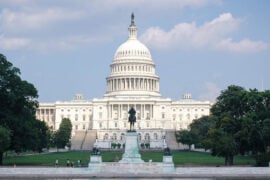Tax News and Developments December 2022
In brief
On 26 September 2022, the US Court of Appeals for the Eleventh Circuit, issued an opinion in United States v. Meyer, 50 F.4th 23 (11th Cir. 2022), holding that the Anti-Injunction Act (“AIA”), codified in Code Section 7421, did not bar a defendant taxpayer from seeking a protective order in a closed suit to restrain the government from using his admissions when assessing a tax penalty in a separate administrative proceeding. In reversing the district court, the Eleventh Circuit determined that a protective order was not a suit for purposes of the AIA, and limited the IRS’s ability to use the AIA to override procedural protections that taxpayers would otherwise have in a non-tax proceeding.
In more detail
A taxpayer is generally barred from bringing a “suit” that enjoins IRS assessment or collection activities. See §7421. The purpose of the AIA is to protect “the Government’s ability to collect a consistent stream of revenue, by barring litigation to enjoin or otherwise obstruct the collection of taxes.” Nat’l Fed’n of Indep. Bus. v. Sebelius, 567 U.S. 519, 543, 132 S. Ct. 2566, 183 L. Ed. 2d 450 (2012). Recently, the Supreme Court clarified the contours of the AIA in CIC Servs., LLC v. IRS, 141 S. Ct. 1582 (2021) in determining whether a material advisor could challenge the lawfulness of IRS Notice 2016-66 (the “Notice”), which set forth a reporting obligation for micro-captive insurance transactions. In a unanimous decision, the US Supreme Court held that the AIA did not bar taxpayer’s suit challenging the Notice because that taxpayer’s suit was not an action against the tax penalty itself for at least three reasons: (1) the Notice imposed affirmative reporting obligations, which created non-tax administrative burdens separate from the potential tax penalty; (2) the reporting obligation was several steps removed from the tax penalty; and (3) violations of the Notice resulted in not only civil tax penalties, but also criminal punishment, which “practically necessitate[d] a pre-enforcement, rather than a refund, suit.” Id. at 1592.
In United States v. Meyer, 50 F.4th 23 (11th Cir. 2022), the government again advocated for a broad reading of the AIA. Meyer was a defendant in a lawsuit that the Department of Justice initiated in 2018 to enjoin Meyer from advising his clients to claim more than USD 35 million in federal income tax deductions for allegedly fictitious charitable contributions. Over the course of the suit and extensive discovery process, the government served and Meyer responded to over 1,500 requests for admissions. The parties eventually settled the case with Meyer agreeing to a permanent injunction, and the US District Court for the Southern District of Florida entered a final judgment in April 2019.
The IRS subsequently opened a penalty exam, and in July 2020 sent a notice to Meyer proposing an assessment of nearly USD 7.1 million in section 6700 penalties for advising on an abusive tax shelter. The basis for the IRS’s decision specifically relied on Meyer’s responses to the requests for admissions in the earlier court proceeding. Meyer objected and filed a motion for a protective order in the then-closed district court case, which requested the court to prohibit the IRS from using his admissions in the penalty exam. United States v. Meyer, No. 18-CV-60704-BLOOM/VALLE, (S.D. Fla. Apr. 2, 2021).
The government objected to the motion and argued that the AIA barred a defendant taxpayer from moving for a protective order to restrain the government from using admissions in a separate IRS-initiated administrative proceeding. The district court, adopting the report and recommendation of the magistrate judge, found for the government. On appeal, the Eleventh Circuit reversed the district court decision, focusing on the definition of “suit.” Given the absence of a statutory definition of “suit,” the Eleventh Circuit looked to its ordinary meaning, which at the time of the AIA’s enactment had consistently been understood to mean a “judicial proceeding or action initiated for the purpose of enforcing a right or ensuring compliance with the law.” Meyer, 50 F.4th at 28. Further, the court determined that the term “motion” was not synonymous with suit and had long been understood as distinct from suit. Id. Because the government, and not Meyer, filed the 2018 suit (i.e., the same proceeding in which Meyer subsequently filed the motion for protective order), Meyer’s motion for a protective order was not a suit and, therefore, was not barred by the AIA. Id. at 31. The Eleventh Circuit distinguished many of the cases that the district court cited as support because in those cases the taxpayer seeking relief had initiated the action against the government. The court also rejected the government’s argument that the Seventh Circuit’s decision in United States v. Dema, 544 F.2d 1373 (7th Cir. 1976), favored barring the motion. In Dema, the Seventh Circuit focused on the spirit and purpose of the AIA as justification for dismissing taxpayer’s motion. However, the Eleventh Circuit declined this purposivist approach in favor of applying the clear statutory text, reasoning that Congress could have but chose not employ broader language.
The decision in Meyer is consistent with a more restrictive understanding of the AIA as advanced by CIC Services. Both cases reflect a departure from the notion that any relief sought by the taxpayer which impacts the IRS’ collection activities, no matter how remote or attenuated the impact, is presumptively invalid under the AIA. Rather they endorse a strict reading of the statutory text of the AIA and more measured case-by-case analysis that focuses on the scope and purpose of relief sought by the taxpayer.





